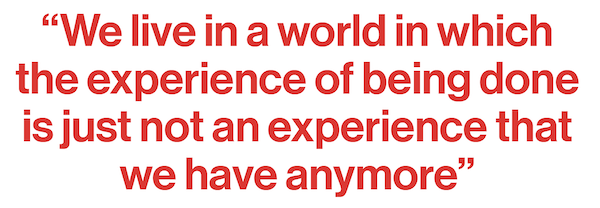Future Now
The IFTF Blog
Algorithms for Intimacy
Interview with Brian Christian
Brian Christian is the author of “The Most Human Human” and, most recently, co-author of “Algorithms to Live By”. For his latest book, Christian teamed up with cognitive scientist Tom Griffiths to examine how we can apply what we’ve learned about computer-based algorithms to our daily lives. We talked with Christian to learn more about how algorithms can help us manage our relationships with others and navigate the human experience.
Let’s start with the title of the book, “Algorithms to Live By”. What’s the origin of the title?
A host of problems confronts us in daily life, whether it’s finding an apartment, deciding whether to go to our favorite restaurant, trying something new, or managing our time and our physical space. We think of these as uniquely human problems. The thesis of the book is quite simply that they’re not. There are deep parallels between the problems humans face in everyday life and some of the canonical problems of computer science, and so we have a real opportunity to learn something about making better decisions in our own lives.
There are several areas of the book that I was intrigued by, but one was in your chapter on networking algorithms, about dealing with unreliable people. How does this apply to human relationships?
We give an example in the book of a friend of ours who had a family member with a history of drug addiction. There can be this issue where you offer this person lodging in your house and buy them new clothes and spend money on food and all these things and then there’s this recurring pattern of the person disappearing again and coming back x weeks later with the same story. You never want to say, “This person is beyond redemption, ”but at the same time, you don’t want to be taken advantage of repeatedly, so what do you do?
Our typical approach in cases like this is to define some number of times to immediately forgive, and then a threshold beyond which to just firmly shut the person out of your life: “Three strikes and you’re out.” But how do you possibly make that decision? These can be situations that are legitimately agonizing. The concept here, which I think is really critical, is one that’s called “exponential backoff.” Exponential backoff actually provides a Goldilocks between these two extremes. The idea is that you back off the rate at which you’re trying. Specifically, the default is that you wait twice as long after each successive failure. (This is why it’s called exponential backoff.) For a machine trying to connect to a server that’s not responding, first it tries again in 1/10th of a second, then 2/10ths of a second, then four, eight, sixteen, and so forth. There’s something nice about how agnostic the system can be here. There’s no line in the sand. You can actually have a policy that deals pretty well with those situations by just being completely consistent. Exponential backoff offers some consolation or, at least, another way of approaching the problem that gets one out of that emotional dilemma.

In the book, you wrote, “The most prevalent critique of modern communications is that we are ‘always connected.’ But the problem isn’t that we’re always connected; we’re not. The problem is that we’re always buffered. The difference is enormous.” What’s the difference and why should we pay attention to it?
One of the canonical problems in networking is what do you do when the flow of data in exceeds the flow of data out. Imagine—for a router, let’s say—what does the router do when it’s receiving packets faster than it can send packets? At the most basic level, one of two things can happen. It can just ignore those packets, which is called “taildrop,” or the alternative, is to buffer it.
If you go on vacation and 100 people have rung your doorbell and gotten no response and then walked away, that’s the equivalent of tail drop. Instead, if the 100 people have emailed you, then the emails just start to stack up and when you return you find this full buffer and you still have to deal with everything that’s happened while you were away. I think these two strategies for dealing with being overwhelmed are the main two strategies that exist in human minds. If too many things are happening at once, either you just don’t do most of them, or you create this backlog. I think we’ve been engineering a world in which things just don’t get dropped.
How do you do that gracefully in situations where you really do need to be selective about what you’re paying attention to and what you’re not paying attention to?
One of my favorite examples of tweaking the buffering-to-tail-drop dial comes from an academic called Tom Stafford. At one point in the writing of the book, my collaborator and I emailed him to try to ask him something, and we got a message back that said, “I am now on sabbatical until June 12th. Your email has been deleted.”
I think there’s a lesson, which is, as we move into the 21st century, it just becomes ever easier to buffer everything—because we can, because the storage is so cheap. That does not, by any means, mean that we should.
It’s interesting to think about that in the context of Snapchat and ephemeral messaging. We need to accept that we can’t see everything and not try to buffer everything in such a way that we’ll eventually circle back to it.
The other thing about not buffering so much is that it gives you the ability to actually be done. Imagine if you went onto Facebook and it said, “Here are all of the things from today,” and you read them all, and then you’re just…done. It’s this joke because we live in a world in which the experience of being done is just not an experience that we have anymore.
 FUTURE NOW—When Everything is Media
FUTURE NOW—When Everything is Media
In this second volume of Future Now, IFTF's print magazine powered by our Future 50 partnership, we explore the future of communications, tracing historical technology shifts through the present and focusing on the question: “What is beyond social media?”
Think of Future Now as a book of provocations; it reflects the curiosity and diversity of futures thinking across IFTF and our network of collaborators. This issue contains expert interviews, profiles and analyses of what today’s technologies tell us about the next decade, as well as comics and science fiction stories that help us imagine what 2026 (and beyond) might look and feel like.
About IFTF's Future 50
Every successful strategy begins with an insight about the future. Every organization needs to build the capacity to anticipate the future. The Future 50 is a side-by-side relationship with Institute for the Future; it’s a partnership focused on strategic foresight on a ten-year time horizon. With 50 years of futures research in society, technology, health, the economy, and the environment, IFTF has the perspectives, networks, signals, and tools to make sense out of the emerging future.
For More Information
For more information on IFTF's Future 50 Partnership and Tech Futures Lab, contact:
Sean Ness | sness@iftf.org | 650.233.9517



